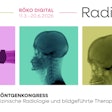Dear AuntMinnieEurope Member,
Chest x-ray reporting is notoriously tricky and prone to human error, so it's just the sort of everyday task in which artificial intelligence (AI) can play a central role. The problem, though, is chest x-ray reports were never intended to be used for the development of radiology AI and are an opinion as well as an educated guess, writes Dr. Hugh Harvey.
In his latest column, he explains exactly how AI can help in this area and what obstacles need to be overcome. Click here to find out more.
Researchers from the south coast of England also have taken a close look at errors. They found radiology is not a binary process, the final radiology report is influenced by many variables, and the correct answer is not always "normal" or "abnormal," "cancer" or "not cancer." They also noted discrepancies are alarmingly common when it comes to chest x-rays, and urgent action is essential. Get the full story.
Digital breast tomosynthesis (DBT) continues to generate interest, especially as new studies demonstrate its utility. Last week, Dr. Per Skaane in Norway and his team released two-year follow-up data from the Oslo Tomosynthesis Screening Trial, concluding that using DBT in conjunction with full-field digital mammography significantly increased screen-detected cancers and specificity. Go to the Women's Imaging Community, or click here.
Meanwhile, an audit service is helping to reduce costs, boost productivity, and sharpen radiologists' skills in Russia. The Unified Radiological Information Service in Moscow already assesses 150 CT, MRI, and mammography systems across 64 outpatient departments, and the service is gearing up for further expansion. Visit the CT Community, or click here to read more about the venture.
As 3D printing technology evolves and its cost reduces, patient-specific 3D-printed brain arteriovenous malformation models may become routine for both clinical and educational use, according to a new study. Learn more in the Advanced Visualization Community, or click here.



















